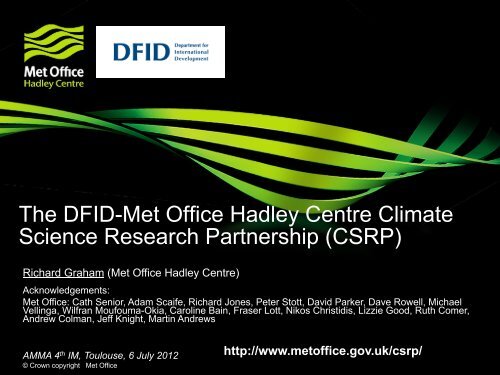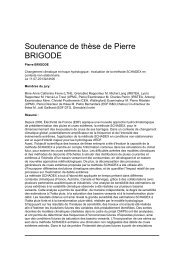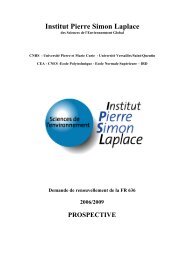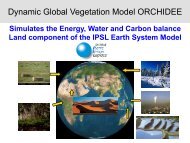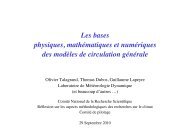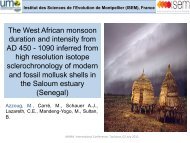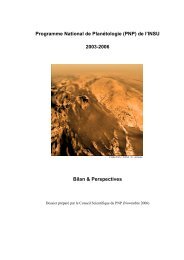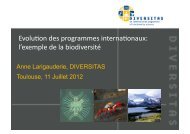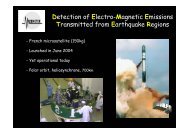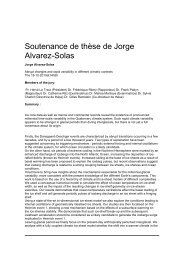The DFID-Met Office Hadley Centre Climate Science Research Partnership (CSRP)
CSRP - Colloque CNFCG 2012
CSRP - Colloque CNFCG 2012
You also want an ePaper? Increase the reach of your titles
YUMPU automatically turns print PDFs into web optimized ePapers that Google loves.
<strong>The</strong> <strong>DFID</strong>-<strong>Met</strong> <strong>Office</strong> <strong>Hadley</strong> <strong>Centre</strong> <strong>Climate</strong><br />
<strong>Science</strong> <strong>Research</strong> <strong>Partnership</strong> (<strong>CSRP</strong>)<br />
Richard Graham (<strong>Met</strong> <strong>Office</strong> <strong>Hadley</strong> <strong>Centre</strong>)<br />
Acknowledgements:<br />
<strong>Met</strong> <strong>Office</strong>: Cath Senior, Adam Scaife, Richard Jones, Peter Stott, David Parker, Dave Rowell, Michael<br />
Vellinga, Wilfran Moufouma-Okia, Caroline Bain, Fraser Lott, Nikos Christidis, Lizzie Good, Ruth Comer,<br />
Andrew Colman, Jeff Knight, Martin Andrews<br />
AMMA 4 th IM, Toulouse, 6 July 2012<br />
© Crown copyright <strong>Met</strong> <strong>Office</strong><br />
http://www.metoffice.gov.uk/csrp/
<strong>CSRP</strong>: Project Goal and Purpose<br />
Goal:<br />
Vulnerable societies and decision makers in developing<br />
countries to follow climate resilient development<br />
pathways<br />
Purpose:<br />
Improved knowledge and climate science capacity<br />
provides robust evidence on current and likely future<br />
climate conditions, for use by decision makers in Africa.<br />
<strong>Science</strong> and Capacity Building outputs
<strong>CSRP</strong>: climate and modelling research,<br />
applications, capacity building – Africa<br />
3-year programme, started January 2010<br />
Initial consultation with African users of climate predictions<br />
• To determine priority prediction and capacity building needs<br />
<strong>Science</strong> component:<br />
1. Improved understanding and modelling of drivers of African<br />
climate – remote (e.g. ENSO), local (e.g. soil moisture); (C. Senior)<br />
2. Develop ‘seamless’ monthly-decadal system, trial new ‘userdriven’<br />
predictions, monitoring and ‘attribution’; (A. Scaife)<br />
3. Regional <strong>Climate</strong> Model downscaling – towards higher spatial<br />
detail in forecasts (PRECIS); (R. Jones)<br />
Capacity building component: (R. Graham)<br />
4. <strong>CSRP</strong> Fellowship scheme: 11 fellows appointed;<br />
5. Workshops: Capacity building workshops in climate science<br />
© Crown copyright <strong>Met</strong> <strong>Office</strong>
Outputs 1: Improved understanding<br />
and modelling<br />
© Crown copyright <strong>Met</strong> <strong>Office</strong>
How well do models used in IPCC’s AR4<br />
represent observed correlations between<br />
large-scale sea-surface temperature (SST) and<br />
African seasonal rainfall?<br />
Rainfall and SST Areas<br />
Rainfall regions defined<br />
such that interannual<br />
anomalies are spatially<br />
homogeneous and<br />
temporally homogeneous<br />
(month-to-month)<br />
1) Compute timeseries of area-average rainfall for 6 regions over Africa: Sahel (JAS),<br />
Guinea Coast (JAS), Kenya-Somalia (OND), Tanzania (OND), Zimbabwe (ND), SW.Africa (DJF)<br />
2) Compute timeseries of area-average SST or SST dipoles for 6 tropical regions for<br />
each of the above seasons: Tropical Atlantic Dipole, Equatorial Atlantic, Mediterranean, Central<br />
Indian Ocean, Indian Ocean Dipole, Nino3.4<br />
3) Do this with data from: Observations (CRU3.1 and HadISST1.1) and 25 coupled<br />
models<br />
© Crown copyright <strong>Met</strong> <strong>Office</strong> <br />
Dave Rowell
Are Some Teleconnections Easier to<br />
Model than Others?<br />
Skill of Model Teleconnections<br />
• Teleconnections that are easier<br />
to model:<br />
• Indian Ocean – Tanzania<br />
• Indian Ocean Dipole –<br />
Kenya-Somalia<br />
• Mediterranean – Sahel<br />
• Teleconnections that are hard<br />
to model:<br />
• Equatorial Atlantic –<br />
Guinea Coast<br />
• ENSO – Kenya-Somalia<br />
Skill Indicator: Significance level for rejection of<br />
a null hypothesis that model and observed SSTrainfall<br />
correlations derive from the same<br />
population<br />
© Crown copyright <strong>Met</strong> <strong>Office</strong> <br />
Dave Rowell
Teleconnections:<br />
Role of SST and Precipitation Biases<br />
SST Biases<br />
Precip Biases<br />
Eq. E. Atlantic<br />
→<br />
Guinea Coast<br />
worst best<br />
teleconnections<br />
Equatorial East Atlantic<br />
Nino 3.4<br />
Guinea Coast<br />
Kenya-Somalia<br />
• No obvious<br />
relationship<br />
between model<br />
teleconnection<br />
skill and the<br />
SST or precip<br />
biases in the<br />
teleconnection<br />
regions.<br />
ENSO<br />
→<br />
Kenya-Somalia<br />
• <strong>The</strong> causes<br />
of model<br />
teleconnection<br />
errors are not<br />
straightforward!<br />
Dave Rowell
Sahel<br />
Guinea coast<br />
Rainy season onset – focus on West Africa<br />
How well do models used in IPCC’s AR4 represent<br />
WAM season onset?<br />
West African Monsoon (latitude Vs time)<br />
Average onset date<br />
observed<br />
HadGEM3(dev)<br />
Sample of CMIP3 models from AR4 (20c3m)<br />
• Most AR4 coupled models do not<br />
have a good representation of the<br />
West African Monsoon (WAM);<br />
• Implications for confidence in<br />
predictions of how climate change<br />
will impact the WAM;<br />
• Good representation in HadGEM3<br />
provides opportunity to improve<br />
understanding of mechanisms<br />
driving onset;<br />
• Good representation of land surface, and<br />
the remote influence of sea surface<br />
temperature are important for forecasting<br />
timing of onset<br />
Michael Vellinga
Land Surface Feedbacks<br />
using GLACE framework<br />
Ensemble mean of zonally averaged (10ْW- 10ْE) precipitation (mm/day)<br />
Control Prescribed Soil Moisture Difference (prescribed<br />
– control)<br />
Onset<br />
dates<br />
Onset definition:<br />
pentad when maximum<br />
rainfall moves and stays<br />
north of 10°N<br />
Ruth Comer
Role of local vs remote forcing:<br />
Nudging techniques<br />
JJA 1983-2002: 600hpa winds<br />
GA3.0 control – ERA40<br />
Experiments with relaxing model back to<br />
re-analysis over prescribed domains to<br />
identify remote influences on African<br />
climate and influence of Africa on global<br />
climate (following Klinker, 1990)<br />
Initial global studies:<br />
• WAM (10S-40N; 30W-60E)<br />
• S.A Monsoon (10S-40N; 60E-150E)<br />
Monsoon nudge– ERA40<br />
• Similar to Flaounas et al, we find impact<br />
of Asian monsoon on simulation of East<br />
Africa<br />
Wilfran Moufouma-Okia
African Easterly Waves: Role of physics<br />
REANALYSIS/ OBS<br />
SEASONAL FORECAST<br />
Curvature vorticity 700hPa (5-15N)<br />
GPCP rain rate (10-15N)<br />
Curvature vorticity 700hPa (5-15N)<br />
Model rain rate (10-15N)<br />
Model AEWs are realistic, but too slow, less frequent, do not<br />
enhance rainfall sufficiently<br />
Caroline Bain
Output 2: Trial new prediction<br />
products, monitoring, attribution,<br />
seamless monthly-decadal system<br />
© Crown copyright <strong>Met</strong> <strong>Office</strong>
Predicting onset timing<br />
based on local time of arrival of 20% of long-term seasonal<br />
average<br />
Average southward<br />
progression of rains with ITZC<br />
Skill of <strong>Met</strong> <strong>Office</strong> seasonal<br />
forecasts of onset timing<br />
observed<br />
Example:<br />
East Africa<br />
short-rains<br />
(OND)<br />
early onset<br />
orange/red =<br />
‘good’ skill<br />
modelled<br />
late onset<br />
Encouraging first results: trial onset forecasts have been provided to<br />
Regional <strong>Climate</strong> Outlook Forums ICPAC, ACMAD and SADC-DMC<br />
Michael Vellinga
New products: onset prediction and<br />
monitoring<br />
Example: Greater Horn of Africa, short-rains season<br />
2011– predicted with one month lead<br />
Early onset<br />
predicted<br />
most likely<br />
Early onset<br />
occurred<br />
Probability of early<br />
‘onset’<br />
Probability of<br />
late ‘onset’<br />
Prediction is based<br />
on local time of<br />
arrival of 20% of<br />
long-term seasonal<br />
average<br />
<strong>CSRP</strong> monitoring<br />
product: Observed<br />
time of ‘onset‘ (in<br />
days difference<br />
from long-term<br />
average<br />
• Assessment over retrospective<br />
cases indicates forecast can<br />
discriminate early/late onset in<br />
~70% of cases (Tanzania/Kenya)<br />
• Onset forecasts being trial at<br />
regional centres in East, West and<br />
southern Africa<br />
Michael Vellinga/Lizzie Good
Predicting onset timing: West African<br />
season 2011 (July-Sept) predicted from May<br />
based on local time of arrival of 20% of long-term seasonal average<br />
Probability of early arrival<br />
Probability of late arrival<br />
Observed time of arrival<br />
Michael Vellinga/Lizzie Good
Africa observational monitoring<br />
Observed, JAS 2011<br />
Observed anomalies (rel. 1983-2011)<br />
Observed terciles (rel. 1983-2011)<br />
Also…<br />
• maps showing latest<br />
dry spell length<br />
• climatological<br />
averages<br />
• Plots using CPC-<br />
FEWS and TRMM<br />
Also weekly updating plots…<br />
Latest info on East Africa<br />
long-rains season March-May<br />
2012<br />
Lizzie Good
Attribution of extreme events<br />
there is a growing tendency to attribute all observed extremes to<br />
man-made climate change – bringing potential for mal-adaptation<br />
schematic<br />
Greater Horn of Africa short-rains OND 2010<br />
P 0 : Probability of exceeding<br />
a threshold in a “natural<br />
world” (no anthropogenic<br />
forcings).<br />
Obs 2010<br />
P 1 : Probability of exceeding<br />
a threshold in the real world.<br />
F AR = 1 – (P 0 / P 1 )<br />
Obs 2010 Obs 2009<br />
Natural and actual world actual world simulations for<br />
simulations for OND 2010 OND 2009 and 2010<br />
(100 realisations each)<br />
• Severe drought characterised by poor rains OND 2010 and MAM 2011<br />
Preliminary results:<br />
• Little ‘man-made’ influence detected on OND season – natural forcing (La<br />
Niña) likely increased risk of dry (consistent with known teleconnections)<br />
• For MAM season: some evidence that man-made influence increased risk of<br />
dry (consistent with Funk et al 2008) – but more research needed<br />
2010<br />
2009<br />
Fraser Lott, Nikos Christidis, Peter Stott
‘Seamless’ monthly-to-decadal prediction:<br />
Skill for El Nino/La Nina prediction to 18 months ahead<br />
correlation skill for monthly Niño3.4 index to 5<br />
years ahead; from 22 retrospective forecasts<br />
from 1 st November – 95% confidence limits<br />
<br />
<br />
<br />
• Positive skill for El Niño/La Niña prediction retained to ~18 months.<br />
• Showing potential for longer-lead rainfall outlooks in regions strongly<br />
influenced by ENSO – allowing more time to prepare responses to<br />
potential drought/flood.<br />
Jeff Knight / Martin Andrews
HadCM3 DePreSys Vs HadGEM3<br />
‘DePreSys’: November starts yrs2-5<br />
ACC temperature<br />
ACC rainfall<br />
• HadGEM3 is more skilful than HadCM3<br />
• Capability for multi-annual prediction over Africa has been improved<br />
Jeff Knight / Martin Andrews
Output 3: Regional <strong>Climate</strong> Model<br />
downscaling<br />
© Crown copyright <strong>Met</strong> <strong>Office</strong>
Development of PRECIS V3 for<br />
regional modelling over Africa<br />
Wilfran Moufouma-Okia<br />
Bias in HadGEM3-RA 50km simulations of June-August rainfall<br />
Previous model version Latest model version<br />
Reduced wet<br />
bias over<br />
Congo basin<br />
• Improved HadGEM3 RCM (PRECIS V3) will be implemented in an African<br />
centre and used in trial downscaling of seasonal forecasts in 2012<br />
• Tested at 135km, 50km, 25km, 12km horiz. res.<br />
• Exploring potential to provide the greater spatial detail required by users
<strong>Science</strong> component (3):<br />
Resolution experiments with<br />
HadGEM3-RA (JJA)<br />
135km<br />
50km<br />
25km<br />
Wilfran Moufouma-Okia<br />
Rainfall bias<br />
w.r.t GPCP<br />
Impact of<br />
resolution<br />
Observational<br />
uncertainty<br />
50km-135km 25km-135km CRU-GPCP
Output 4/5: Capacity Building:<br />
Fellowship scheme, climate science<br />
workshops, support to Regional <strong>Climate</strong><br />
Outlook Forums,<br />
© Crown copyright <strong>Met</strong> <strong>Office</strong>
Various <strong>Met</strong> <strong>Office</strong><br />
mentors<br />
Fellowship scheme / workshops:<br />
<strong>CSRP</strong> Fellowship scheme<br />
• 11 African climate scientists<br />
appointed as <strong>CSRP</strong> fellows;<br />
• 4 West; 4 East Africa; 1 Central<br />
and 2 southern Africa;<br />
• Fellows will work on <strong>CSRP</strong><br />
research themes;<br />
• Each fellow has been assigned a<br />
(<strong>Met</strong> <strong>Office</strong>) expert as mentor;<br />
• Fellows are based at African<br />
Institutes, with 4-week visit to the<br />
<strong>Met</strong> <strong>Office</strong>
<strong>CSRP</strong> fellows<br />
• Dr Ousmane Ndiaye: National Agency of Civil<br />
Aviation and <strong>Met</strong>eorology (ANACIM), Dakar,<br />
Senegal<br />
• Mr Ismaila Diallo: Cheikh Anta Diop University<br />
(UCAD), Laboratory for Atmospheric Physics<br />
Simeon Fongang (LPASF); Dakar, Senegal<br />
• Dr Willem Landman: Council for Scientific and<br />
Industrial <strong>Research</strong> (CSIR), Pretoria, South Africa<br />
• Mr Mekonnen Adnew Degefu: Department of<br />
Geography and Environmental Studies,University of<br />
Addis Ababa, Ethiopia<br />
• Mr Wilfried Pokam Mba: University of Yaoundé 1<br />
and <strong>Centre</strong> for International Forestry <strong>Research</strong><br />
(CIFOR), Yaoundé, Cameroon<br />
• Mr Arlindo Meque: National Institute of<br />
<strong>Met</strong>eorology (INAM), Maputo, Mozambique and<br />
University of Cape Town, South Africa<br />
• Mrs Mary Kilavi: Kenya <strong>Met</strong> Department, Nairobi,<br />
Kenya<br />
• Mr Oumar Konte: National Agency of Civil Aviation<br />
and <strong>Met</strong>eorology (ANACIM), Dakar, Senegal<br />
• Dr Philip Omondi Aming’o: IGAD <strong>Climate</strong><br />
Prediction and Applications <strong>Centre</strong> (ICPAC),<br />
Nairobi, Kenya<br />
• Mr Dominic Soami Pokperlaar: Ghana<br />
<strong>Met</strong>eorological Agency, Accra, Ghana<br />
• Mr Geoffrey Sabiiti: Makerere University, Kampala,<br />
Uganda and IGAD <strong>Climate</strong> Prediction and<br />
Applications <strong>Centre</strong> (ICPAC), Nairobi, Kenya<br />
• Forecasting weather statistics within the climate of<br />
the seasonal rainfall over Senegal<br />
• Present day simulations of the West African<br />
Monsoon with two kinds of HadGEM3 model (GCM<br />
and RCM)<br />
• <strong>The</strong> performance of HadGEM3 as a seasonal<br />
forecasting and research tool for southern African<br />
climate variability<br />
• Association between rainfall variability and global<br />
climate teleconnection: the case of southwestern<br />
Ethiopia<br />
• Investigation of processes driving low-level<br />
westerlies in central Africa<br />
• Evaluation of the GloSea4 seasonal forecast system<br />
over Mozambique: rainfall climatology and<br />
predictability<br />
• Integrating dynamical products into national and<br />
regional climate outlook forum products<br />
• Evaluation of seasonal forecasting of rainfall from<br />
the farmer’s perspective with Kaffrine and Fatick as<br />
case studies<br />
• Modelling decadal climate variability over the<br />
Eastern Africa region<br />
• Ghana historical climate data development project<br />
• Evaluating MOHC PRECIS system downscaling<br />
ability and its climate change projections over the<br />
Greater Horn of Africa<br />
© Crown copyright <strong>Met</strong> <strong>Office</strong>
Various <strong>Met</strong> <strong>Office</strong><br />
mentors<br />
Fellowship scheme / workshops:<br />
<strong>CSRP</strong> Fellowship scheme<br />
• 11 African climate scientists<br />
appointed as <strong>CSRP</strong> fellows;<br />
• 4 West; 4 East Africa; 1 Central<br />
and 2 southern Africa;<br />
• Fellows will work on <strong>CSRP</strong><br />
research themes;<br />
• Each fellow has been assigned a<br />
(<strong>Met</strong> <strong>Office</strong>) expert as mentor;<br />
• Fellows are based at African<br />
Institutes, with 4-week visit to the<br />
<strong>Met</strong> <strong>Office</strong><br />
Workshops in climate science and<br />
applications<br />
• ‘Use of dynamical seasonal forecasts for<br />
the Greater Horn of Africa’ – hosted by<br />
ICPAC Nairobi (June 2011);<br />
• 15 participants from countries of the GHA;<br />
• Tools and methods developed helping to<br />
enhance regional seasonal forecasting;<br />
• Opportunities for longer-range (ENSObased)<br />
predictions explored – potential for<br />
longer-lead drought/flood warnings.
<strong>CSRP</strong> support to African Regional <strong>Climate</strong><br />
Outlook Forums (RCOFs)<br />
<strong>Met</strong> <strong>Office</strong> prediction:<br />
Greater Horn of Africa (GHACOF29)<br />
consensus forecast for Sept-Dec 2011 –<br />
forecast made at peak of drought crisis<br />
P(abv)<br />
GHACOF consensus forecast<br />
Observed rainfall<br />
category (Oct-Dec)<br />
P(avg)<br />
• Above average rainfall<br />
predicted most likely<br />
P(blw)<br />
Andrew Colman<br />
P(abv)<br />
P(avg)<br />
P(blw)<br />
45<br />
35<br />
20<br />
• Above average<br />
occurred<br />
• Some alleviation from<br />
drought
X:CFS model output<br />
Rainfall forecast<br />
CCA Example:CFS prediction of MAM<br />
East African Rainfall<br />
Andrew Colman<br />
Model (red) v Obs (green)<br />
Y:Corresponding<br />
Observed rainfall<br />
CFS Rainfall forecast for MAM 2011<br />
© Crown copyright <strong>Met</strong> <strong>Office</strong> <br />
Andrew Colman<br />
Probability of<br />
above average<br />
rainfall tercile<br />
(chance=33%)
Recommendations to African <strong>Climate</strong><br />
Policy <strong>Centre</strong> (UNECA, Addis Ababa)<br />
• Increased Africa-focussed climate research is urgently<br />
needed to improve models and reduce prediction<br />
uncertainties in user-relevant climate variables;<br />
• Performance tests (diagnostics) for user-relevant<br />
variables should be agreed for climate models and<br />
monthly-seasonal-interannual prediction systems.<br />
Results of testing should be published;<br />
• <strong>The</strong> above must be guided by increased liaison<br />
between model developers and the African climate<br />
prediction and user communities (Regional <strong>Centre</strong>s,<br />
NMSs and Regional <strong>Climate</strong> Outlook Forums);<br />
• Application of longer-range (~6 months – 2 years)<br />
dynamical model ENSO predictions is a particular<br />
opportunity for Africa.<br />
(Recommendations are consistent with priorities of the<br />
Global Framework for <strong>Climate</strong> Services, GFCS)<br />
Richard Graham
http://www.metoffice.gov.uk/csrp<br />
Thank you.<br />
Questions?<br />
© Crown copyright <strong>Met</strong> <strong>Office</strong>


